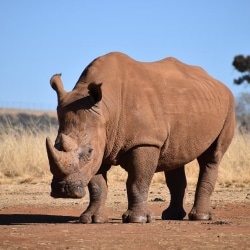Supporting Rhino Conservation

Rhino’s are one of the world’s most iconic species that is critically under threat. Here are 5 Rhino facts showcasing this beautiful animal, and information on how you can help support WWF in rhino conservation.
1. There are 5 species of rhino
There are two African rhino species; black and white rhinos, and three Asian rhino species; greater one-horned, Sumatran and Javan rhinos.
The IUCN lists the Sumatran, Javan and Black rhinos as critically endangered. There are believed to be less that 100 Javan and Sumatran rhinos left in the wild. White rhinos are classified as ‘near threatened’ with around 10,000 in the wild and the greater one-horned is listed as vulnerable.
2. Rhinos can weigh over 3 tonnes
White rhinos are the largest of the rhino species, weighing over 3 tonnes (3,500 kg). The smallest is the Sumatran rhino, but they are still pretty large weighing in at 600kg.
3. Black and white rhino’s are both grey
White and black rhino’s are confusingly named given that neither of them are black or white, they are both grey. It is thought that the white rhino gained its name from the Afrikaans word for wide (‘wyd’), because of its wide square lip. This term was mistaken by European explorers to be ‘white’ and the black rhino was named accordingly so as to differentiate them from the white species.
4. Rhino’s don’t see too well
Rhino’s have a strong sense of smell but poor eyesight. They can’t make out objects over 30m away, so rely on their smell to inform them of their surroundings.
5. They love mud
Asian rhinos are good swimmers and are used to crossing rivers. However, African rhinos are poor swimmers and can drown when out of their depth. Therefore African rhinos prefer to wallow in mud to cool down.
Supporting Rhino Conservation
Rhino’s are critically under threat from poaching and habitat loss.
Roughly 2 rhinos are killed by poaching every day in Africa. Poachers constantly find new and innovative ways to evade the authorities. Helicopters are used to illegally track the rhinos, and once the animals are shot, their horns are quickly removed, and airlifted away. If the rhino isn’t already dead, it will often bleed to death.
The horns are highly prized in Asia, predominantly used in powdered form within traditional medicine.
Habitat loss and fragmentation are an increasing threat to rhinos, as human populations and infrastructure grows, encroaching on rhino habitat.
If you would like to find out more about supporting WWF and their rhino conservation please visit our Adopt a Rhino page.



